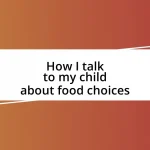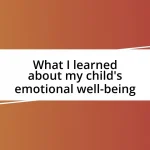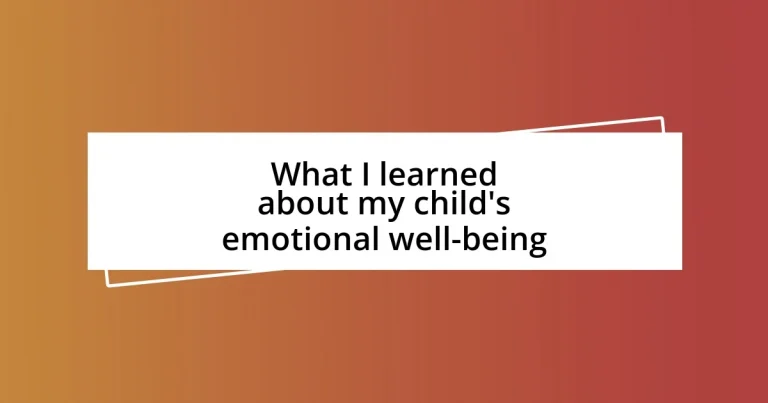Key takeaways:
- Understanding emotional well-being is essential for recognizing and addressing children’s feelings, which can improve family dynamics and emotional support.
- Emotional literacy empowers children to articulate their emotions, fostering self-awareness, empathy, and effective communication.
- Building resilience involves encouraging problem-solving, embracing challenges, and adapting strategies based on children’s emotional needs to promote their growth and confidence.
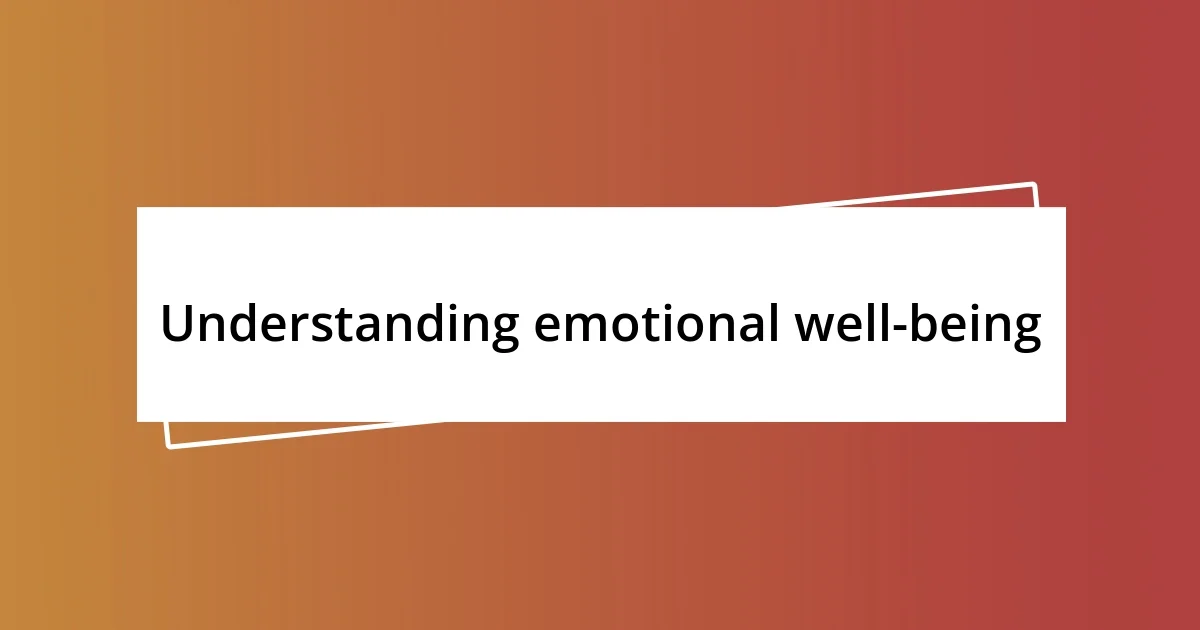
Understanding emotional well-being
Understanding emotional well-being is crucial because it shapes how children perceive the world and interact with others. I remember a time when my child had a meltdown after a playdate, and I couldn’t help but wonder: what was going on beneath the surface? It turned out that feeling left out during play triggered deep emotions, showing me just how vital it is to acknowledge those feelings rather than brush them aside.
Emotional well-being encompasses a range of feelings, from happiness to anxiety. I realized that my child’s emotional state often mirrored our household environment; when I was stressed, he seemed more unsettled. This revelation made me think about how emotional health isn’t just an individual concern—it’s interconnected with the family dynamic. Are we, as parents, creating a safe space for our children to express themselves?
I’ve learned that recognizing signs of emotional distress—like changes in behavior or withdrawal—can make a significant difference. One afternoon, I found my son quietly drawing alone while he usually buzzed around with energy. It prompted me to ask open-ended questions about his feelings, facilitating a conversation that unveiled a lot of unspoken worries. This experience reinforced my belief that understanding emotional well-being allows us to support our children more effectively.
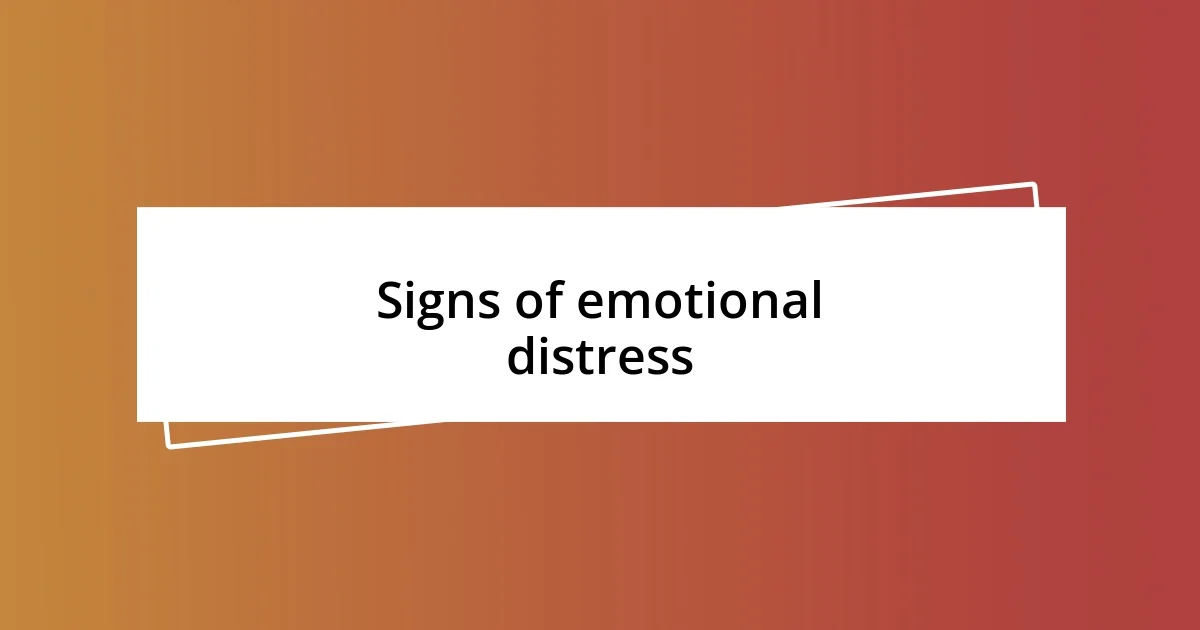
Signs of emotional distress
Recognizing emotional distress in children is often subtle yet crucial. For instance, after a seemingly normal day, I noticed my daughter’s once vibrant laughter was replaced by silence and reluctance to engage. It dawned on me that changes in mood or energy levels can indicate deeper feelings that require our attention. This shift made me realize that even small alterations in behavior can speak volumes about their internal struggles.
Another time, I discovered my son was reluctant to participate in activities he once loved. He used to eagerly rush to soccer practice, but when he suddenly expressed dread, I sensed a red flag. His reluctance was often accompanied by clinginess toward me, showcasing a struggle with separation anxiety that I hadn’t recognized before. These patterns can reveal a lot about our children’s emotional states and should never be ignored.
In my experience, both emotional withdrawal and physical symptoms—like stomachaches—can signal distress. After a tough week at school, my daughter began complaining of tummy troubles more frequently. It led me to ask questions and dive deeper into her feelings, ultimately uncovering anxieties about friendships. Observing these signs and addressing the underlying issues is essential for a healthy emotional environment.
| Signs of Emotional Distress | Examples |
|---|---|
| Behavior Changes | Withdrawal from activities they once enjoyed |
| Emotional Withdrawal | Increased silence or reluctance to engage |
| Physical Symptoms | Complaints of headaches or stomachaches |
| Clinginess | Increased attachment to parents during stressful times |
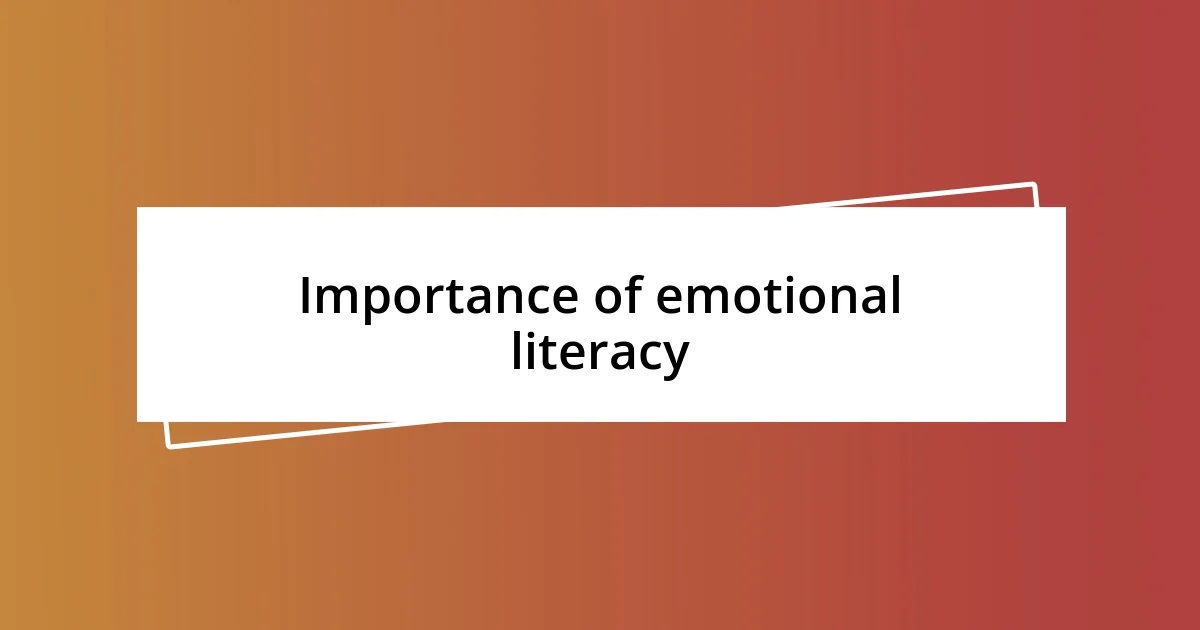
Importance of emotional literacy
Importance of emotional literacy
Emotional literacy is the ability to recognize, understand, and express emotions effectively. During a particularly challenging week, I noticed my child struggling with frustration over homework. Instead of lashing out, he started to articulate his feelings, saying, “I feel overwhelmed.” This pivotal moment showed me how crucial it is for children to have the vocabulary to express what they’re experiencing.
When children develop emotional literacy, they not only manage their own feelings better but also navigate social interactions more effectively. I witnessed this firsthand when my daughter used to express her jealousy during a friend’s birthday party. Rather than bottling it up, she shared her emotions with me, leading to a valuable discussion about empathy. This ability to articulate feelings contributes to building deeper connections with peers and adults alike. Here are some of the key benefits of fostering emotional literacy:
- Enhances self-awareness: Children become mindful of their feelings, which helps in regulating emotions.
- Improves communication skills: They learn to express their thoughts and emotions, leading to better relationships.
- Increases empathy: Understanding their own emotions enables them to recognize and respect others’ feelings.
- Reduces anxiety: When kids can identify their emotions, they cultivate effective coping strategies.
- Builds resilience: Emotionally literate children are better equipped to face challenges and recover from setbacks.

Effective communication strategies
Effective communication starts with active listening. I remember one evening when my son, visibly upset after school, wanted to talk. Rather than jumping in with my own observations, I simply sat beside him and encouraged him to share his thoughts. “What made your day tough?” I asked. That small act of listening opened the door for him to express his feelings, making him feel valued and understood.
Another strategy I’ve found effective is validating their emotions. I often remind myself that saying, “It’s okay to feel sad about what happened,” can go a long way. One time, my daughter was upset about not being invited to a friend’s party. Instead of brushing it off, I acknowledged her feelings by saying, “I understand why that would hurt.” This not only helped her feel seen but also created a safe space where she could share further without fear of being dismissed.
It’s also essential to be clear and age-appropriate in communication. When discussing tough topics, I strive to use simple language my kids can understand. For example, when I spoke to my daughter about a recent family loss, I carefully explained what happened in a way that reassured her, saying, “It’s normal to feel confused or sad when someone we love is gone.” This approach not only provided clarity but also fostered a sense of comfort, inviting her to ask questions and express any fears she might have had. Wouldn’t it be amazing if every child felt this level of openness when discussing their feelings?
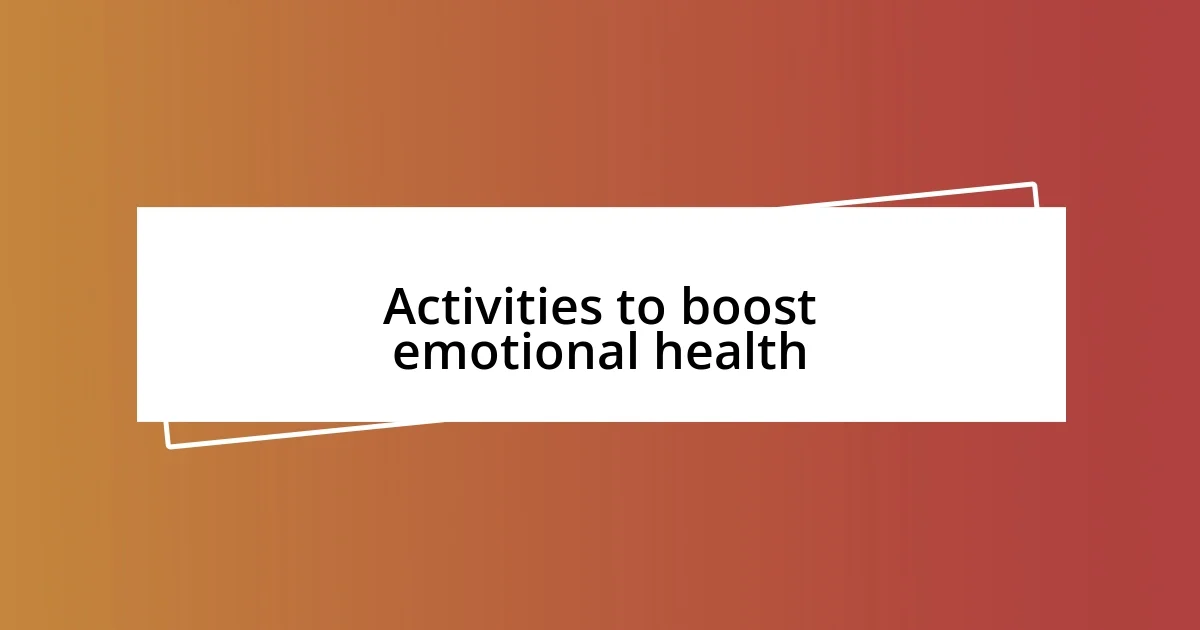
Activities to boost emotional health
One delightful activity I’ve found that truly elevates my child’s emotional health is creative expression through art. Just last weekend, my daughter and I set up a painting station in our backyard. As she splashed color across the canvas, I noticed her verbalizing her thoughts, saying things like, “This blue makes me feel calm” and “The red is for my excitement!” It was amazing to see how the act of creating unlocked not just her artistic side but also her ability to talk about her feelings in a vibrant, tangible way. Isn’t it fascinating how art can serve as a bridge to our emotions?
Mindfulness activities have also become integral to our routine. I introduced short yoga sessions, where we focus on deep breathing and relaxation together. During one session, my son said, “I feel really peaceful right now.” It made me realize that even simple, shared moments can create a safe space for emotional connection. These practices not only ground them but also equip my children with tools for self-regulation during challenging times. Could incorporating mindfulness at home be the secret to greater emotional resilience?
Incorporating nature walks into our week has proven to be a treasure trove for emotional growth. I vividly recall a day we ventured to a nearby park. As we walked, my daughter spotted a butterfly, and her eyes lit up. I encouraged her to express what she felt at that moment, leading to a spontaneous conversation about beauty and fragility in nature. This not only deepened her appreciation for the world around her but also helped her recognize and share her emotions openly. How often do we overlook the simplicity of nature as a nurturing tool for our kids’ emotional well-being?

Building resilience in children
Building resilience in children involves fostering a mindset that embraces challenges as opportunities for growth. I recall an afternoon when my son faced a difficult math problem and became frustrated. Instead of solving it for him, I asked, “What do you think you could try next?” His eyes lit up as he realized that persistence was crucial. In that moment, he learned that struggling isn’t a failure, but a stepping stone to mastering something new. Isn’t it empowering when children discover their own strength to tackle obstacles?
Promoting a growth mindset also means allowing children to experience failure in a supportive environment. There was a time when my daughter didn’t make the soccer team she wanted to join. While she was disheartened, I shared a story from my own childhood about a sports team I didn’t make, too. Instead of dwelling on her disappointment, I encouraged her to view it as a chance to improve and try again next year. I could see the spark return to her eyes as she began to plan how she would train over the next several months. Could these experiences serve as pivotal moments that shape our children’s approach to setbacks?
Another practical approach to building resilience is involving children in problem-solving discussions. One evening, we faced a scheduling dilemma that left us all a bit stressed. I gathered my kids and asked, “How can we make this work together?” Their ideas surprised me! Not only did we come up with a plan, but the experience instilled in them a sense of agency and teamwork. It reminded me that when children participate in finding solutions, they develop confidence and a belief that they can handle life’s curveballs. Could we all benefit from listening to our children’s voices in our family dynamics?
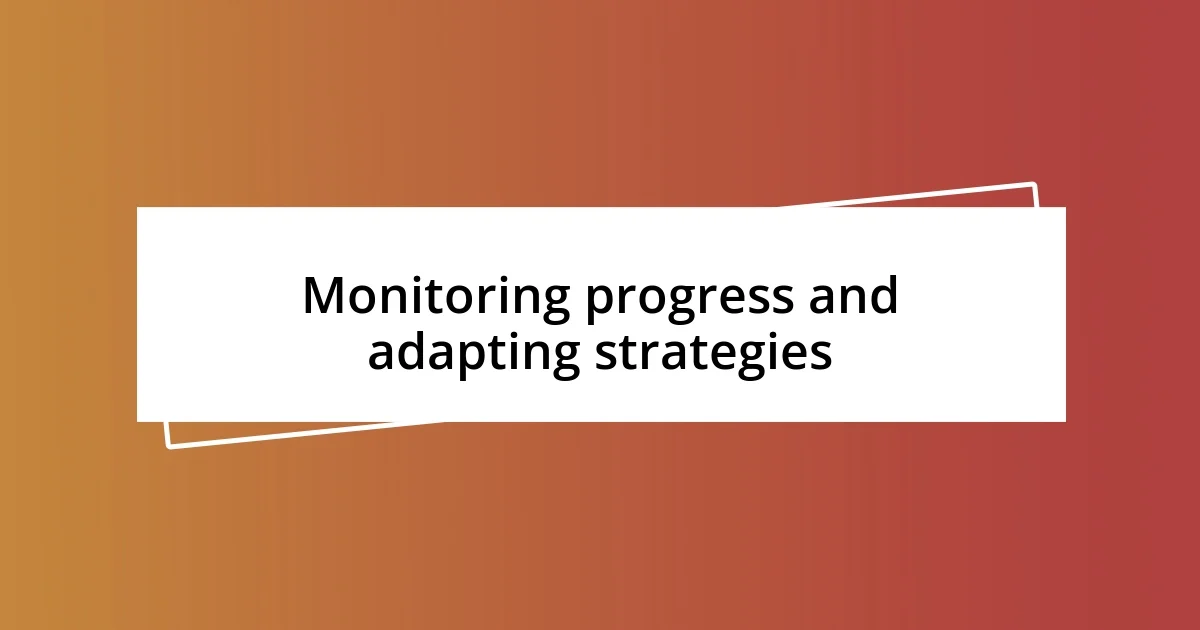
Monitoring progress and adapting strategies
Tracking my children’s emotional progress has been a revealing journey for me. I’ll never forget the moment I started keeping a simple journal of their behaviors and moods. I noticed patterns—certain activities made them more engaged while others led to frustration. This reflection not only helped me see which strategies were effective but also prompted me to ask, “What can I tweak to enhance their emotional experience today?”
I’ve learned that adapting our approach is crucial. For example, during a particularly stressful week, I noticed my daughter clinging to her tablet out of boredom and unease. Instead of insisting on outdoor play, I decided to introduce her to a calming storytelling podcast. To my surprise, she eagerly engaged with the stories and began drawing her favorite characters, reigniting her spark for creativity. How often do we overlook the small adjustments that can make a significant impact on our children’s emotional states?
Regularly checking in with my kids about how they’re feeling has also been a game changer. Just the other day, after school, I asked my son how he felt about a project he was anxious about. As we unpacked his thoughts together, I learned he was worried about disappointing his teacher. By actively listening and validating his feelings, I was able to suggest a few ways to approach the project that eased his worries. Isn’t it amazing how simply connecting in those moments can serve as a powerful strategy for emotional growth?









